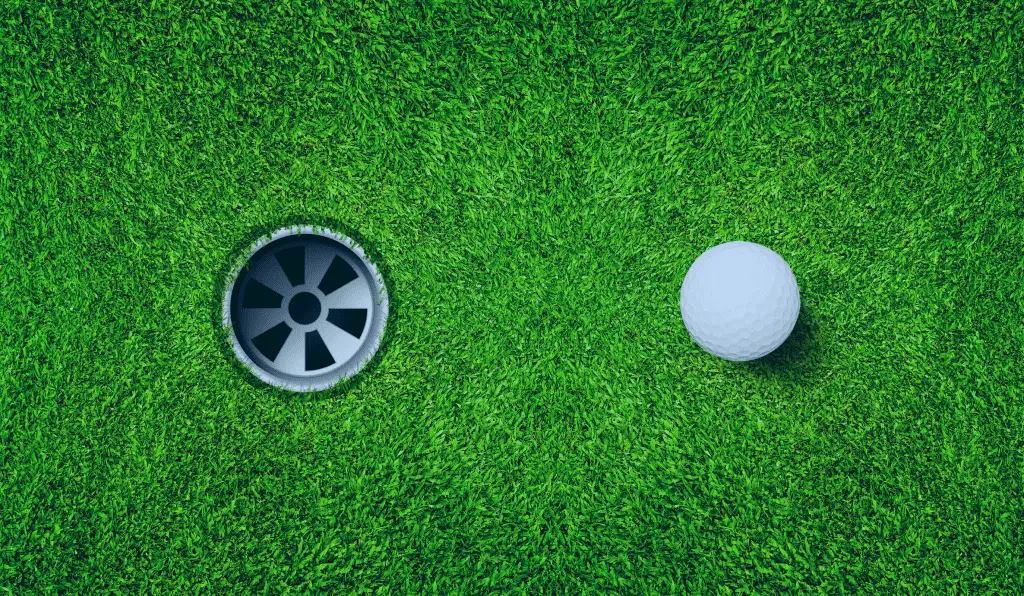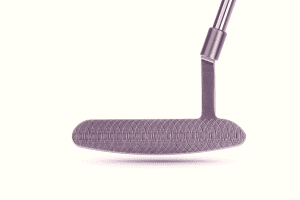Gone are the days where Titleist was the only ball worth using. Finally, the Pro V1 is in for some competition! The Callaway Chrome Soft is a four-piece ball that offers plenty of distance spin and control. But which is better? Today we will find out as we compare the Chrome Soft vs Pro V1 in a head-to-head review!
Chrome Soft Vs Pro V1 | What you Need to Know
The Callaway Chrome Soft is a worthy contender that offers most, if not all, of the performance of the Titleist Pro V1. It feels just a little softer and costs slightly less. Our test also found that it is a little longer than the Pro V1 when playing with irons. If you’re looking for an alternative to a well-established brand, then this could be a great choice. Many tour pros have been using these golf balls. They are ideally suited for mid and low handicap players.
Chrome Soft Review at a Glance

The Callaway Chrome Soft is a four-piece golf ball designed to offer the best of all worlds. With the bigger clubs, you should see relatively low spin rates, promoting both distance and straighter shots.
When it comes to mid-iron shots, it offers a decent amount of spin and control. You’ll have the ability to shape your shots and also have stopping power when hitting into the green.
In the short game, the Chrome soft has great spin control and, as the name suggests, should give a soft feel.
The head of research and development at Callaway says:
“We’ve reinvented Tour ball performance again with Chrome Soft to give golfers more of what they want – long distance, great feel, and exceptional spin control from tee-to-green.”
It is considered a ‘premium’ golf ball. You’ll find it in the golf bag of many tour pros, including Phil Mickelson, John Rahm, and Xander Schauffele.
But it isn’t only for the pros. The Callaway Chrome Soft golf ball has been specifically developed to offer softness and forgiveness, even if you are a ‘weekend warrior’.
Here are its features and what makes it a great golf ball:
A Larger Core
The central core of the Callaway Chrome Soft has been made significantly larger. The aim is to create a higher launch while also reducing spin. This is particularly useful when playing longer shots as it should offer more distance.
Ionomer High-Speed Mantle
The mantle, the area surrounding the larger core, has been redesigned to ensure efficient energy transfer. This should offer a slightly faster ball speed off the face.
Thinner Cover
This could be the key to the success of the Callaway Chrome Soft. The outer cover has been made thinner. As a result, the ball should spin less when hit with woods but still generate a good spin rate when hit with wedges and short irons.
Graphene Reinforced Cover
Between the outer cover and inner mantle is a thin layer of Graphene, a type of carbon. This layer adds durability to the ball. It also helps to increase the spin required on approach shots and your short game.
Optimized Dimples
Look closely at the Callaway Chrome Soft, and you might notice a subtle difference. The dimples are hexagonal instead of round. Callaway maintains that this is the most drag-efficient design. In addition, they promise that it offers a higher ball flight, perfect for those 150-yard approach shots into the green.
Does the Technology Match the Performance in the Callaway Chrome Soft?
In a word?
Yes.
Generally speaking, the ball looks and feels as premium as its price tag. However, we’ll dig into the specifics in our head-to-head comparison between the Chrome Soft vs. Pro V1 below.
For now, what we will say is that the ball does feel really soft. On the launch monitor, it did everything that Callaway suggests.
Shots with the driver had a low spin, and we found it did make us slightly straighter, with a moderate increase in distance.
Mid Irons performed well. The spin was exactly in the region we’d expect from other premium golf balls, and out on the course, we could get a respectable amount of stopping power when attacking the pin.
The short game performance was equally impressive. Wedge shots hit the green and really gripped. When putting the ball felt buttery soft, with no ‘clacky’ sound or feel.
Pro V1 Review at a Glance

The Pro V1 has been seen as a ‘players ball’ for as long as we can remember. Many still maintain that it is the best premium golf ball available. Considering that it has been around for over two decades, it certainly has an elevated position.
But what does it offer, and what made it so great?
The Pro V1 was one of the first premium balls that offered great distance along with soft feel and control around the green. Essentially an all-in-one package that offered everything a ‘player’ could want.
It is a 3 piece golf ball comprising a large core, a thin casing layer, and a soft outer elastomer cover.
You’ll find it in the bag of a great many tour pros, including Viktor Hovland, Louis Oosthuizen, and Jessica Korda.
Here are its features: –
A Redesigned Core
Titleist hasn’t stood still for the last 20 years. The Pro V1 has a reformulated 2.0 ZG process core. This is relatively solid. The aim of this technology is to offer faster speeds off the clubface. It should also help to reduce spin when hitting with woods and long irons. As a result, you should expect to see increased distance.
A High Flex Casing Layer
Spin reduction is key to longer, straighter shots. The thin casing layer covers the larger core and is engineered to lower long game spin.
A Soft Cover
One key area in the success of the Titleist Pro V1 was its soft feel. Titleist says that the current generation of Pro V1’s has the softest cover they have ever used. Is this the case? Absolutely. It still feels as soft as ever.
It isn’t just about feel. We also want to see performance. Titleist provides. As has been the case for the last twenty years, you can expect to see green gripping control, shot shaping (if you can), and control in and around the green.
Redesigned Aerodynamics
While not a complete redesign, Titleist have upgraded their golf balls. The Pro V1 features a tiled 388 tetrahedral design. The aim is to reduce drag and give a penetrating ball flight.
Does the Performance Match the Technology in the Titleist Pro V1?
Absolutely!
There’s a reason this golf ball has kept its crown for so long. It works!
Provided you can hit it with a reasonable degree of consistency, you should find that you get really good distance, with a large helping of control. Of course, it might not be as forgiving as some low spin golf balls, but that said, they are geared towards a different audience.
Approach shots are a joy with the Pro V1. Provided you can get it ‘on the dancefloor’, you should find that you’ll get a good ‘check and stop’ as a minimum. Advanced players can expect to see significant backspin.
The short game is where the Titleist Pro V1 truly shines. Hitting from a range of less than 100 yards is where you can really expect to see all the benefits of the soft feel elastomer cover. When putting, you’ll get a smooth experience that is almost like hitting a sponge.
Chrome Soft VS Pro V1 Head-to-Head Comparison
So, it’s time to pit the Callaway Chrome Soft against the Titleist Pro V1. On the face of it, they share some common features, and both boast similar performance. However, compared to the Pro V1’s two-decade history, the Callaway Chrome Soft could be seen as an upstart. Will the Titleist hold its crown, or is there a new player in town?
We hit the course with a few sleeves of each golf ball. We also pulled out the launch monitor to get some hard numbers. We hit drives, mid-iron shots with a 7-iron, and finished up with a 58° wedge. Here’s what we found: –
Golf Ball Performance Data
Spin
With a well-struck wedge shot and a premium ‘performance’ golf ball, we normally expect to see somewhere in the region of 10,000 RPM. Neither the Titleist Pro V1 nor the Callaway Chrome Soft left us disappointed, and both performed practically identically.
With a wedge, the Pro V1 gave an average spin of 10,020 RPM. The Chrome Soft came out at an average of 10,005. The difference is practically non-existent.
With the mid irons, you are looking for some spin, but not enough that you start to lose distance or accuracy. We normally say that anything around 5,000 RPM is optimum.
While we couldn’t really see the difference out on the course, the launch monitor told a different story. The Pro V1 did outperform the Chrome Soft when it came to spin with a mid-iron. We saw the Titleist Pro V1 offer around 5400 RPM. The Chrome Soft was below at around 5050 RPM. That’s nearly a difference of 10%!
But… That might not be a bad thing.
Why?
We also saw a moderate increase in distance with the Chrome Soft. On average, it traveled 2 yards further than the Pro V1.
If you think that is insignificant, think again. 2 yards is 6 feet. Would you rather a 12-foot putt for a birdie or a 6-footer? These little things make all the difference.
The part where everyone wants to see results is the driver, AKA the ‘big stick’. Both on the course and on the launch monitor, we found both golf balls to be practically inseparable. As you’ll see in the table above, the difference in spin was so negligible as to be insignificant. Both were in the ballpark of what we would expect to see at around 2000 RPM.
Both are bordering on what many would consider a ‘distance ball’ when it comes to spin.
Verdict:
When hitting either ball with a driver or a wedge, both the Titleist Pro V1 spin performance and the Callaway Chrome Soft was practically inseparable. Both offer the kind of spin we like to see.
The Titleist Pro V1 wins by a nose in spin with mid-iron shots. However, if you are looking for a little extra distance, the Chrome Soft might be more suitable.
Feel
Nobody wants to play with a ‘squash ball’. Nor does anyone want to feel like they are hitting a ‘stone’. The Pro V1 has long been regarded as one of the softest golf balls in existence. It was one of its key selling points.
But here’s the thing.
The Chrome soft was perhaps one of the softest balls we’ve ever hit. It has a slightly lower compression ratio when compared to the Pro V1, and it shows. So while some might say it doesn’t suit those with a faster swing speed, remember, there’s plenty of tour pros with Chrome Soft in the bag.
With a driver, you are swinging at speeds where feel makes little difference. However, with the mid-irons and wedges, both balls were exemplary in feel. When we found the middle of the club, there was zero vibration. Both felt smooth and soft.
Verdict:
If you blindfolded us and asked us which ball we’d hit, we’d be able to tell which was the Chrome Soft and which was the Titleist… But only just. The Chrome Soft ‘does what it says on the can’ and is marginally softer. As to which you prefer, that’s down to personal preference. We are calling this one a draw.
Ball Flight
From our table above, you’ll see a range of differences depending on the club. Focussing on the mid-iron shots, the launch angle is ever so slightly different. In reality, when out on the course, this wasn’t apparent.
When it comes to the driver, it is a whole different ball game (pun intended). The Pro V1 had a lower flight, you could see it, and the launch monitor data backs it up. The Callaway Chrome Soft flight did appear a little higher ‘real world’, which was confirmed by the launch monitor, with a difference approaching 2.5°.
Both ball flights are in the range of what we’d expect to see. However, Callaway did suggest that their larger core would encourage higher ball flight, and it would appear that this works, based on the numbers.
Interestingly our average carry between the balls was less than a yard.
Verdict
While the difference isn’t startling, we found the Chrome Soft to offer a slightly higher ball flight. Is there a difference? Yes. Will it make a massive change to your game? Probably not. When it comes to golf ball flight, Chrome Soft just inches ahead, but not by much.
Price
The Titleist Pro V1 retails for around $49 for a dozen golf balls. The Callaway Chrome Soft is around $47 for 15.
If we are digging into minutiae of detail, then the Callaway Chrome Soft golf balls are cheaper. With the price difference, for the money, you are getting two very similar golf balls.
Are either overpriced? Not really. $4 per ball is about the going rate for a premium golf ball.
You can check the latest prices of both here {LINK}
Which Should I Play?
When we compared the data and performance, there is a negligible difference between each ball. So it really boils down to personal preference and what you consider important.
Do you want to stick with the tried and tested Titleist? Or go with the new upstart?
If you want a ball that feels really soft, we would say that the Callaway Chrome Soft takes the lead. It also offered fractionally more distance when playing with mid-irons. The flight was a little higher with the Chrome golf balls too. They are also marginally cheaper than the Titleist Pro V1.
The Titleist Pro V1 produced a higher spin when struck with irons. It also feels a little harder than the Callaway Chrome Soft balls.
The price is similar, and overall the Chrome wins in quite a few categories, but only just. Suppose you want to save a few (literally) dollars but still want performance roughly equal to an established ‘premium’ golf ball. In that case, the Callaway Chrome Soft is a worthy rival.
Chrome Soft VS Pro V1 Comparison | FAQ
Who Should Use Callaway Chrome Soft Golf Balls?
While Callaway designed the Chrome Soft for all players, it is more suited to those who can really get the benefit. High handicappers on the cusp of becoming mid-handicappers might enjoy the benefit. For those with lower handicaps, they perform just as well as other true ‘players’ golf balls.
Are Callaway Chrome Soft Golf Balls Good?
Yes indeed. The results speak for themselves. They have a modest advantage in price, and they also have a slight advantage in distance in mid irons. Our test above shows that in most areas, they easily match the Titleist Pro V1
What is the Compression of Callaway Chrome Soft 2020?
The Callaway Chrome Soft is definitely a mid-compression ball. It sits well in the range of what we would consider a ‘soft’ ball. It certainly feels softer than the Titleist Pro V1.
Final Thoughts
When it comes to making a Chrome Soft VS Pro V1 Comparison, there is very little difference between these two golf balls. If the Titleist Pro V1 can be considered the king, the Callaway Chrome Soft is certainly the Crown prince. Depending on your thoughts on what is good value and how important soft feel is, we would consider this a victory for Callaway. Titleist had better watch out!









